Introduction
The Lincoln Presidency: Last Full Measure of Devotion
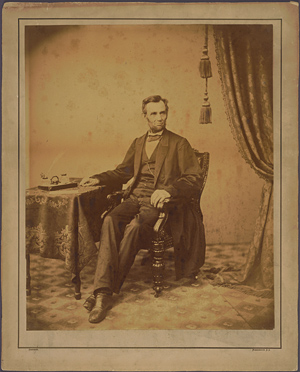
Alexander Gardner. Portrait of Abraham Lincoln. [Washington, November 8, 1863].
Collection of Stephan Loewentheil
Cornell University Library celebrates the 200th anniversary of Abraham Lincoln’s birth with an exhibition documenting Lincoln’s four years as America’s 16th president.
Lincoln assumed office just six weeks before the Civil War began, and he would outlive the official end of the war by only five days. Through original documents, letters, and photographs, this exhibition explores Lincoln’s accomplishments during his years in office, and his belief in freedom for all people under one Union—a principle that would ultimately cost him his life.
Cornell’s collections on Abraham Lincoln and the Civil War date from the founding of the University in 1865. By then, Cornell’s first president, Andrew Dickson White, had amassed a large personal collection of hundreds of pamphlets, posters, advertising leaflets, newspapers, political cartoons, and more—all gathered during the war years. A life-long collector of books and historical materials on many subjects, A.D. White understood that the enterprise of today’s collector makes the work of tomorrow’s historian possible.
White’s collecting endeavors serve as the foundation for many subsequent generations of collectors. The Nicholas H. Noyes family donated a significant archive on Abraham Lincoln in the 1940s and 1950s, including manuscripts documenting three central achievements of Lincoln’s presidency: a copy of the Gettysburg Address in his handwriting, a manuscript of the Emancipation Proclamation, and a manuscript copy of the 13th Amendment. Collectors today continue to support generously the growth of Cornell’s significant holdings on the Civil War era. This exhibition features materials from an extensive Lincoln collection donated by Gail ’56 and Stephen Rudin, as well as materials on loan from the Collection of Stephan Loewentheil, JD ’75.
Acknowledgments
This exhibition has been made possible through the generosity and commitment of Cornell Library’s donors and friends. Funding for the exhibition and associated web site has been provided by a grant from the Nicholas H. Noyes, Jr., Memorial Foundation. Funding for the opening reception and lecture by James McPherson on October 20, 2009 was provided through a gift from Gail ’56 and Stephen Rudin.
Nearly everything presented in these galleries was the gift or loan from dedicated Cornellians and collectors, past and present. Cornell University Library thanks the following friends, without whom this exhibition would not be possible: The Nicholas H. Noyes family and the Nicholas H. Noyes Jr. Memorial Foundation; Gail ’56 and Stephen Rudin; Stephan Loewentheil; Susan H. Douglas; the William P. Stein Memorial Endowment; the Class of 1956 Rare Book and Manuscript Endowment; and the foresight of Cornell’s first collector, Andrew Dickson White.
The engraved portrait of Lincoln that serves as the main publicity image for this exhibition is based on a photograph by Anthony Berger for Mathew Brady. It was taken in Washington on February 9, 1864. It is also the image formerly used for the Lincoln portrait on the five-dollar bill.
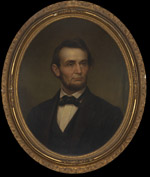 |
Oil painting portrait of Abraham Lincoln, signed “W.R.W., 1865.” [zoom] |
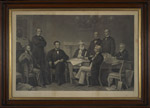 |
Francis Bicknell Carpenter. “First Reading of the Emancipation Proclamation of President Lincoln.” Engraved from Carpenter’s original 1864 oil painting. New York, 1866. [zoom] Gift of John W. Reps |
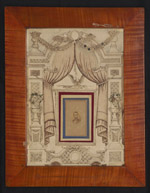 |
Framed Carte-de-Visite Photograph of Lincoln with Surrounding Folk Art Painting. [zoom] A handmade, artistic tribute to the slain President. The date and origin are unknown. Collection of Stephan Loewentheil |
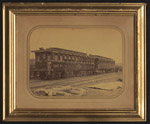 |
Lincoln’s Funeral Train in Buffalo, New York. [Buffalo: M. Beyer, 1865]. [zoom] Buffalo was the sixth stop on the President’s funeral train journey from Washington to Springfield, Illinois. The cars arrived in the early morning hours of April 27, 1865 at Exchange Street Station. The train approached the city slowly, and all in Buffalo stood to witness the event. Collection of Stephan Loewentheil |
View an image of this exhibition case: 1